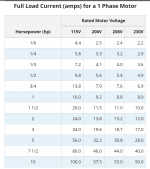Hello,
I have a customer that has a 10HP single phase 230 volt motor on a dust collector that trips out the overload that is built into the motor (reset button on the side of the motor junction box). It trips out after about a half hour of running.
The voltage is good (between phases and phase to ground), amperage is 41 amps per leg and the FLA on the nameplate is 39.
The motor is 3 or 4 years old, and we can easily spin the motor shaft by hand with everything hooked up.
This is your mission if you choose to accept it.
I have a customer that has a 10HP single phase 230 volt motor on a dust collector that trips out the overload that is built into the motor (reset button on the side of the motor junction box). It trips out after about a half hour of running.
The voltage is good (between phases and phase to ground), amperage is 41 amps per leg and the FLA on the nameplate is 39.
The motor is 3 or 4 years old, and we can easily spin the motor shaft by hand with everything hooked up.
This is your mission if you choose to accept it.





